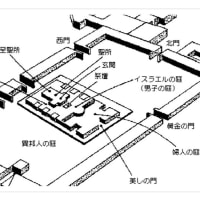マルコの福音書8章 メシヤキリスト
1.四千人の給食(8:1-21)
パンの奇跡は、先の6:30-44にも出てきました。マルコは、同じような記事を二度取り上げています。他方使徒ヨハネは、イエスがたくさんの奇跡を行ったと言いながら(21:25)、この手の記事は全く取り上げていません。おそらくヨハネが福音書を書いた時に、ヨハネは先の三つの福音書を既に読んでいたためなのかもしれません。つまり、ヨハネは、これらよりも取り上げるべきものがあった、と考えたのでしょう。そうしたヨハネの特徴は、また後で共に読んでまいりましょう。
ともあれ、この二度目の記事で注目すべきは、奇跡の後になされた、イエスと弟子たちとの対話の内容です。つまり、マルコの関心は、四千人の胃袋を満たしたイエスの力の偉大さにはありませんでした。むしろ、「まだ分からないのか、まだ悟らないのか」(17節)と叱責される弟子たちの学習能力の低さにあったのです。人は信仰について聞かされて、分かったつもりになっていることが多いものです。しかし、実際には全くわかっておらず、その本質を理解するのは、ずっと後のことであったりします。
そのような意味で、マルコだけが取り上げる次のエピソード、つまりベツサイダでの盲人の癒しは、信仰についての私たちの学習能力について、その現実を象徴的に語るものです。つまりこの奇跡は瞬時には起こらず、時間をかけて完了しています。信仰も時間をかけて成熟していくものです。神の語られたことは必ずなると、と期待を持って成り行きを見守り、深めていく経験です。
実際、マルコも、ペテロの通訳者として、ペテロの郷里(ヨハネ1:44)で起こったこの奇跡を繰り返し通訳させられたはずです。そしてその経験を通して、これを記憶に深く留め、これが、信仰において重要な局面を伝えていることを悟るようになり、これを特別に書き記したと言えるのです。
2.ペテロの信仰告白(8:27-38)
27節、イエスと弟子たちは、ピリポ・カイザリアの村々に出かけられました。そこは今や、イスラエル巡礼の旅では必ず訪れる、水と緑の豊かな場所です。そこでイエスは弟子たちに、問いかけられました。「人々はわたしを誰だと言っていますか」するとペテロがイエスは、キリストであると告白しました。それは、イエスが、旧約聖書に約束されたメシヤであることをはっきりと受け入れることを意味しました。
不思議なことにイエスは、その確信を誰にも言わないようにと口止めをしました。それは、彼らが「信仰」と同様に、彼らが口にした「メシヤ」の意味についてもよく理解していなかったからでしょう。実際イエスが語るメシヤ像は、彼らが期待するものとは全くかけ離れていました。彼らは、一般の人々と同じように政治的な解放者である救い主を期待していました。しかし、イエスが期待していたのは、もっと霊的な救い主です。
ですからイエスは、9:31、10:33と三度に渡って同じことを繰り返し説明し、約束のメシヤは霊的な解放者である、つまり十字架上で人類の身代わりとなって神の怒りを受け、神との和解をもたらす存在であることをわからせようとしていくのです。イエスは、ご自分が、ことばと力で世界を征服するのではなく、十字架上で神の宥めの犠牲となり、万人の魂を救うことが使命であることを語るのです。
34節、「自分を捨て、自分の十字架を負って私に従って来なさい」「捨てる」は、「否定する」とも訳されています。自分を捨てるというのは、一般に考えられているように利己的な自分を否定し、自分を押さえつけることではありません。むしろ、神を否定しやすい自分に気づくことです。気づいて、神を認め、神と対話して生きることを大事にすることです。つまり、神にしがみついてついて来なさいということです。今背負っている十字架の重さがわかる人には、救いのことばと言うべきでしょう。では今日もよき一日となるように祈ります。
Mark 8: Christ the Messiah
1. feeding of the four thousand (8:1-21)
The miracle of the bread was mentioned earlier in 6:30-44. Mark mentions a similar article twice. The apostle John, on the other hand, says that Jesus performed many miracles (21:25), but does not cover this kind of article at all. Perhaps this is because John had already read the three earlier gospels when he wrote his gospel. In other words, John may have thought that there was more to cover than these. We will discuss these characteristics of John together later.
Anyway, what is noteworthy in this second article is the content of the dialogue between Jesus and his disciples that took place after the miracle. In other words, Mark's concern was not with the greatness of Jesus' power in filling the stomachs of 4,000 people. Rather, it was in the disciples' inability to learn as they were rebuked, "Do you not yet understand, do you not yet realize?"(v.17). People are often told about the faith and think they understand it. But in reality, they do not understand it at all, and sometimes it is not until much later that they understand its true nature.
In that sense, the following episode, which only Mark takes up, the healing of the blind man at Bethsaida, is symbolic of the reality of our ability to learn about faith. In other words, this miracle does not happen instantly, but is completed over time. Faith also matures over time. It is an experience of watching and deepening our faith with the expectation that what God has told us will come to pass.
In fact, Mark, as Peter's interpreter, must have had to repeatedly interpret this miracle that took place in Peter's hometown (John 1:44). Through this experience, he came to realize that it conveyed an important aspect of faith, and he wrote it down specifically.
2. Peter's Confession of Faith (8:27-38)
In verse 27, Jesus and His disciples went out to the villages of Philip Caesarea. It is now a place of abundant water and greenery, a must-visit on the pilgrimage to Israel. There Jesus asked the disciples, "Who do they say that I am? Peter confessed that Jesus was the Christ. This meant a clear acceptance that Jesus was the Messiah promised in the Old Testament.
Curiously, Jesus stopped short of telling anyone of his conviction. This was probably because they were not as familiar with the meaning of "Messiah" as they were with "faith. In fact, the image of the Messiah that Jesus spoke of was far from what they expected. They were expecting a Savior who would be a political liberator, just like ordinary people. But what Jesus was expecting was a more spiritual Savior.
Therefore, Jesus explains the same thing over and over again three times in 9:31 and 10:33, trying to make it clear that the promised Messiah is a spiritual liberator, that is, a being who took the place of humanity on the cross, incurred God's wrath, and brought about reconciliation with God. Jesus tells us that His mission is not to conquer the world with words and power, but to become the appeasing sacrifice of God on the cross to save the souls of all.
Verse 34, "Deny yourself, take up your cross and come and follow me," "deny" is also translated as "reject" To renounce oneself is not to deny one's selfish self and hold oneself down, as is commonly thought. Rather, it is to become aware of our tendency to reject God. It is about noticing, acknowledging God, and valuing living in dialogue with God. In other words, cling to God and follow him. For those who understand the weight of the cross they are now carrying, it should be called the word of salvation. I pray that today will be another good day.
















